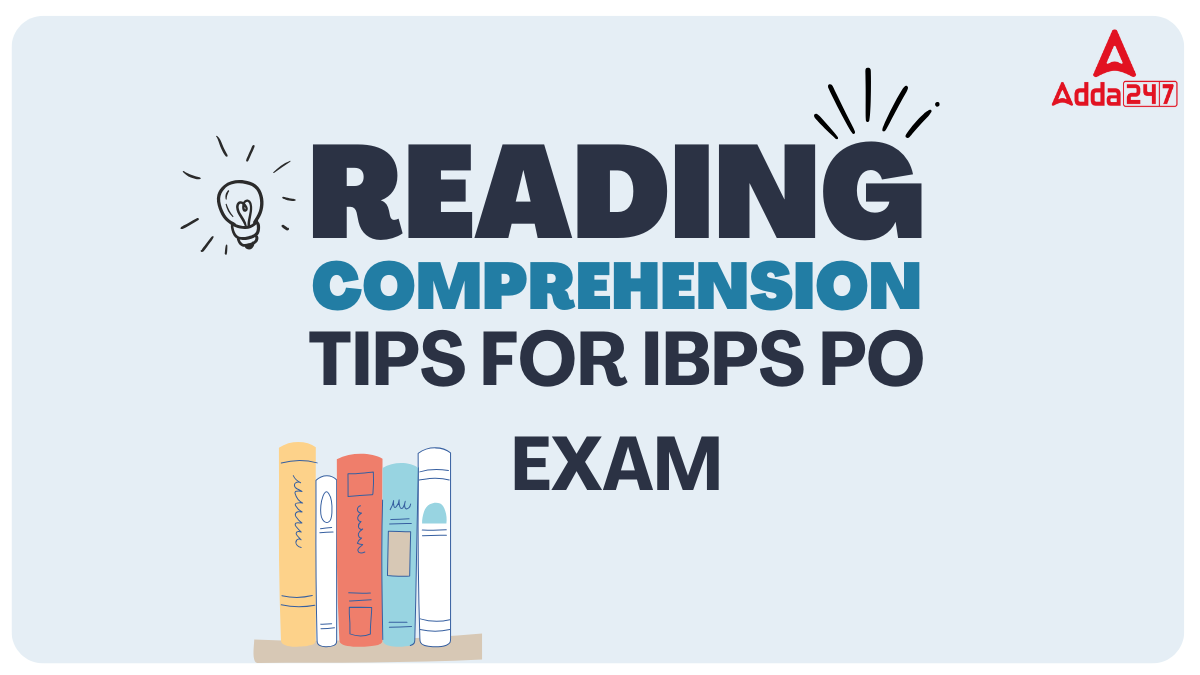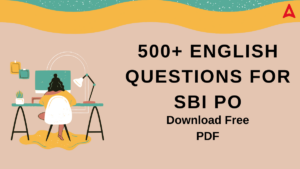Reading Comprehension (RC) is one of the most critical and scoring sections in the IBPS PO exam, especially in the English Language section of both Prelims and Mains. It evaluates a candidate’s ability to understand, interpret, and analyze written content. Unlike vocabulary or grammar questions, RC passages test core comprehension skills, making it essential for candidates to master both accuracy and speed. With increasing competition and a tight time window, knowing the right strategies to tackle RC questions is key to scoring high.
Reading Comprehension for IBPS PO Exam
In the Prelims, RC passages are usually factual and range from 150 to 250 words, followed by 5-7 questions. In the Mains, the passages are longer, more analytical, and often based on themes like economics, current affairs, or social issues, with 7-10 questions per passage. Questions may test direct understanding, inference, vocabulary, tone, and critical reasoning. Thus, a combination of reading speed, comprehension depth, and logical reasoning is essential to succeed.
Common Question Types in IBPS PO RC Section
Understanding these types helps in pre-empting how to approach different questions within the RC set.
- Factual Questions: Directly answered in the passage.
- Inference-Based Questions: Require logical deduction.
- Vocabulary-in-Context: Meanings of words/phrases based on passage usage.
- Tone and Theme Questions: Ask about the author’s attitude or the main idea.
- Title Selection: Best suited title for the given passage.
Reading Comprehension Questions for IBPS PO Exam 2025
Directions (01-05): Read the following passage carefully and answer the questions given below them.
“Popular art” has a number of meanings, impossible to define with any precision, which range from folklore to junk. The poles are clear enough, but the middle tends to blur.
The Hollywood Western of the 1930’s, for example, has elements of folklore, but is closer to junk than to high art or folk art. There can be great trash, just as there is bad high art. The musicals of George Gershwin are great popular art, never aspiring to high art. Schubert and Brahms, however, used elements of popular music—folk themes—in works clearly intended as high art. The case of Verdi is a different one: he took a popular genre—bourgeois melodrama set to music (an accurate definition of nineteenth-century opera—and, without altering its fundamental nature, transmuted it into high art.
This remains one of the greatest achievements in music, and one that cannot be fully appreciated without recognizing the essential trashiness of the genre. As an example of such a transmutation, consider what Verdi made of the typical political elements of nineteenth-century opera. Generally in the plots of these operas, a hero or heroine—usually portrayed only as an individual, unfettered by class—is caught between the immoral corruption of the aristocracy and the doctrinaire rigidity or secret greed of the leaders of the proletariat. Verdi transforms this naive and unlike formulation with music of extraordinary energy and rhythmic vitality, music more subtle than it seems at first hearing. There are scenes and arias that still sound like calls to arms and were clearly understood as such when they were first performed. Such pieces lend an immediacy to the otherwise veiled political message of these operas and call up feelings beyond those of the opera itself. Or consider Verdi’s treatment of character. Before Verdi, there were rarely any characters at all in musical drama, only a series of situations which allowed the singers to express a series of situations which allowed the singers to express a series of emotional states. Any attempt to find coherent psychological portrayal in these operas is misplaced ingenuity. The only coherence was the singer’s vocal technique: when the cast changed, new arias were almost always substituted, generally adapted from other operas. Verdi’s characters, on the other hand, have genuine consistency and integrity, even if, in many cases, the consistency is that of pasteboard melodrama. The integrity of the character is achieved through the music: once he had become established, Verdi did not rewrite his music for different singers or countenance alterations or substitutions of somebody else’s arias in one of his operas, as every eighteenth-century composer had done. When he revised an opera, it was only for dramatic economy and effectiveness.
Q01. Which of the following best describes the relationship of the first paragraph of the passage to the passage as a whole?
(a) It provides a group of specific examples from which generalizations are drawn later in the passage
(b) It leads to an assertion that is supported by examples later in the passage
(c) It defines terms and relationships that are challenged in an argument later in the passage.
(d) It briefly compares and contrasts several achievements that are examined in detail later in the passage.
(e) It explains a method of judging a work of art, a method that is used later
Q02. The author refers to Schubert and Brahms in order to suggest
(a) that their achievements are no less substantial than those of Verdi
(b) that their works are examples of great trash
(c) the extent to which Schubert and Brahms influenced the later compositions of Verdi
(d) a contrast between the conventions of nineteenth-century opera and those of other musical forms
(e) that popular music could be employed in compositions intended as high art
Q03. It can be inferred that the author regards Verdi’s revisions to his operas with
(a) regret that the original music and texts were altered
(b) concern that many of the revisions altered the plots of the original work
(c) approval for the intentions that motivated the revisions
(d) puzzlement, since the revisions seem largely insignificant
(e) enthusiasm, since the revisions were aimed at reducing the conventionality of the operas’ plots
Q04. According to the passage, one of Verdi’s achievements within the framework of nineteenth-century opera and its conventions was to
(a) limit the extent to which singers influenced the musical compositions and performance of his operas
(b) use his operas registered as forums to protest both the moral corruption and dogmatic rigidity of the political leaders of his time
(c) portray psychologically complex characters shaped by the political environment surrounding them
(d) incorporate elements of folklore into both the music and plots of his operas
(e) introduce political elements into an art form that had traditionally avoided political content
Q05. It can be inferred that the author of the independence from social class of the heroes and heroines of nineteenth-century opera as
(a) an idealized but fundamentally accurate portrayal of bourgeois life
(b) a plot convention with no real connection to political reality
(c) a plot refinement unique to Verdi
(d) a symbolic representation of the position of the bourgeoisie relative to the aristocracy and the proletariat
(e) a convention largely seen as irrelevant by audiences
Directions (06-10): In the given passage several blanks are given and for each blank four alternatives are provided with two words each. Choose the option from which both words can fill in the blanks to make a grammatically correct and contextually meaningful sentence. If none of the given options can fit the blank then choose option ‘None of these’ as your answer.
For approximately half the U.S. electorate, a nightmare that began with the unlikely election of Donald Trump to the presidency, is beginning to look as if it may _____ (06) _____ into a second term. The U.S. President’s current approval rating (at 49%, in one poll) is the highest it has been since the day he took office. Initial hopes that his evident _____ (07) _____ and incompetence may lead to an early termination of his presidency have gradually given way to a shocked realisation that no matter what he does, says, or tweets, there is no _____ (08) _____ in his support among those who voted for him in the 2016 election or in the Republican party. Indeed, as the abortive attempt to impeach him underlined, his command over the party is stronger than ever today. The eruption of each _____ (09) _____ scandal followed by Mr. Trump’s brazen strategy of a scorched-earth counterattack has led the U.S. to a point where it is now impossible to conceive of any scenario that could lead his supporters to rethink their _____ (10) _____. A seemingly hyperbolic comment made by Mr. Trump way back in January 2016, when he was a complete outsider among the aspirants for the Republican nomination (“I could stand in the middle of Fifth Avenue and shoot somebody and I wouldn’t lose any voters”) is reality today.
Q06.
(a) Frugal, Goodly
(b) Continue, Stay
(c) Nominal, Wasteful
(d) Abolish, Annihilate
(e) None of these
Q07.
(a) Establishment, Significance
(b) Forecast, Augur
(c) Blistering, Breathless
(d) Venality, Corruptibility
(e) None of these
Q08.
(a) Diminution, Attenuation
(b) Magnitude, Appreciate
(c) Brisk, Dizzy
(d) Depression, Devaluation
(e) None of these
Q09.
(a) Chaos, Muddle
(b) Conjuration, Charm
(c) Outrageous, Shocking
(d) Calm, Quiet
(e) None of these
Q10.
(a) Defy, Scorn
(b) Allegiance, Adherence
(c) Annex, Arrogate
(d) Distress, Anguish
(e) None of these
Directions (11-15): Read the following passage carefully and answer the questions given below it.
Management is a set of processes that can keep a complicated system of people and technology running smoothly. The most important aspects of management include planning, budgeting, organising, staffing, controlling, and problem solving. Leadership is a set of processes that creates organisations in the first place or adapts them to significantly changing circumstances. Leadership defines what the future should look like, aligns people with that vision, and inspires them to make it happen despite the obstacles. This distinction is absolutely crucial for our purposes here. Successful transformation is 70 to 90 per cent leadership and only 10 to 30 per cent management. Yet for historical reasons, many organisations today don’t have much leadership. And almost everyone thinks about the problem here as one of managing change.
For most of this century, as we created thousands and thousands of large organisations for the first time in human history, we didn’t have enough good managers to keep all those bureaucracies functioning. So many companies and universities developed management programs, and hundreds and thousands of people were encouraged to learn management on the job. And they did. But people were taught little about leadership. To some degree, management was emphasized because it’s easier to teach than leadership. But even more so, management was the main item on the twentieth-century agenda because that’s what was needed.
For every entrepreneur or business builder who was a leader, we needed hundreds of managers to run their ever-growing enterprises. Unfortunately for us today, this emphasis on management has often been institutionalized in corporate cultures that discourage employees from learning how to lead. Ironically, past success is usually the key ingredient in producing this outcome. The syndrome, as I have observed it on many occasions, goes like this: Success creates some degree of market dominance, which in turn produces much growth. After a while keeping the ever-larger organization under control becomes the primary challenge. So, attention turns inward, and managerial competencies are nurtured. With a strong emphasis on management but not leadership, bureaucracy and an inward focus take over. But with continued success, the result mostly of market dominance, the problem often goes unaddressed and an unhealthy arrogance being to evolve. All of these characteristics then make any transformation effort much more difficult.
Arrogant managers can over-evaluate their current performance and competitive position, listen poorly, and learn slowly. Inwardly focused employees can have difficulty seeing the very forces that present threats and opportunities. Bureaucratic cultures can smother those who want to respond to shifting conditions. And the lack of leadership leaves no force inside these organizations to break out of the morass.
Q11. Which of the following is not the characteristic of bureaucratic culture?
(a) Managers listen poorly and learn slowly.
(b) Managerial competencies are nurtured.
(c) Employee clearly see the forces that present threats and opportunities.
(d) Prevalence of unhealthy arrogance.
(e) Managers tend to stifle initiative and innovation.
Q12. Which of the following statements is NOT TRUE in the context of the passage?
(a) Bureaucratic culture smother those who want to respond to changing conditions.
(b) Leadership produces change and has the potential to establish direction.
(c) Pressure on managers come mostly from within.
(d) Leadership centres on carrying out important functions such as planning and problem solving.
(e) Managers believe that they are the best and that their idiosyncratic traditions are superior.
Q13. Why did companies and universities develop programmes to prepare managers in such a large number?
(a) Companies and Universities wanted to generate funds through these programmes.
(b) The large number of organisations were created and they needed managers in good number.
(c) Organisations did not want to spend their scarce resources in training managers.
(d) Organisations wanted to create communication network through trained managers.
(e) None of these
Q14. Management education was emphasized in the management programs because:
(a) establishing direction was the main focus of organisations.
(b) motivating employees was thought to be done by managers.
(c) strategies for producing change was the main focus of organisations.
(d) organisations wanted to create powerful guiding coalition.
(e) management was the main item agenda in organizations.
Q15. How, the author, has defined management?
(a) It is the process of adapting organisations to changing circumstances.
(b) It is the system of aligning people with the direction it has taken.
(c) It refers to creating a vision to help direct the change effort.
(e) Creating better performance through customer orientation.
(d) None of these
Directions (16-20): Read the following passage carefully and answer the questions given below it. Certain words are given in bold to help you locate them while answering some of the questions.
There are many things that make us what we are – how we live, the languages we speak, what we eat, wear, the games we play and the things we celebrate. All of these are influenced both by the geography and history of the place where we live. You will get an idea of how diverse India is if you look even briefly at the following statement:
There are eight major religions in the world. Every single one of them is practised in India. We have more than 1600 languages that are people’s mother tongues, and there are more than a hundred dance forms.
Yet this diversity is not always celebrated. This is because we feel safe and secure with people who look, talk, dress and think like us. Sometimes when we meet people who are very different from us we may find them strange and unfamiliar. At times we may not understand or know the reasons why they are different from us. People also form certain attitudes and opinions about others who are not like them.
When our opinions about certain people are always negative, then these become prejudices that we carry about them. Prejudice means to judge other people negatively or see them as inferior. When we think that only one particular way is the best and right way to do things we often end up not respecting others, who may prefer to do things differently. For example, if we think English is the best language and other languages are not important, we are judging these other languages negatively. As a result, we might not respect people who speak languages other than English. We can be prejudiced about many things: people’s religious beliefs, the colour of their skin, the region they come from, the accent they speak in, the clothes they wear etc. Often, our prejudices about others are so strong that we don’t want to form friendships with them. At times, we may even act in ways that hurt them.
Q16. What influences those aspects which make us what we are? Choose the correct option based on the information given in the passage?
(a) The languages we speak
(b) Geography and history of the place where we live.
(c) What we eat
(d) Both (a) and (c)
(e) None of the above
Q17. Why diversity is not always celebrated?
(a) People feel safe and secure with those who look, talk, dress and think like us.
(b) People sometimes find those who are very different from us as strange and unfamiliar.
(c) People do not believe in secularism.
(d) Options (a) and (b)
(e) None of the above
Q18. Which of the followings might happen when a person named ‘Akriti’ meets Akash who is very different from her? Answer the question based on the information given in the passage without assuming anything else.
(I) Akriti may find Akash strange and unfamiliar.
(II) Akriti may form certain attitudes and opinions about Akash.
(III) Akriti will definitely dislike Akash.
(a) Only (III)
(b) Both (II) and (I)
(c) Both (II) and (III)
(d) Both (I) and (III)
(e) All of (I), (II) and (III)
Q19. Which of the options correctly mention the condition for an opinion about certain people to be a prejudice?
(a) The opinions about certain people are neutral always.
(b) The opinions about certain people are positive always.
(c) The opinions about certain people are negative always.
(d) Options (a) or (c)
(e) None of the above
Q20. Which of the following statement is a correct example of prejudice?
(a) Father of Suresh thinks that only graduates from IIT colleges are successful while the graduates from other colleges are not.
(b) Mother of Akansha thinks that her daughter would be happy only if she would marry someone who belongs to a certain caste and religion.
(c) Sameek thinks that only those females who are housewives deserve respect but those women who are working have degraded the values.
(d) Options (a) and (b)
(e) Options (a), (b) and (c)
| Answers | |||||||||
| 01 | 02 | 03 | 04 | 05 | 06 | 07 | 08 | 09 | 10 |
| b | e | c | a | b | b | d | a | c | b |
| 11 | 12 | 13 | 14 | 15 | 16 | 17 | 18 | 19 | 20 |
| c | d | b | e | e | b | d | b | c | e |
Solutions
S01. Ans.(b)
Sol. Option (b) best describes the relationship of the first paragraph of the passage to the whole passage. Initially the paragraph has mentioned about the different types of quality art that is available. Later on, the author has further supported his statement by providing different examples of such art such as the Hollywood western’s art and Verdi’s musical art. Also, author has used example of Schubert and Brahms to explain his views on folkart.
S02. Ans.(e)
Sol. Refer the second last sentence of the second paragraph “Schubert and Brahms, however, used elements of popular music—folk themes—in works clearly intended as high art.”
S03. Ans.(c)
Sol. Refer the last sentence of the passage “When he revised an opera, it was only for dramatic economy and effectiveness.”
S04. Ans.(a)
Sol. Refer the last paragraph of the passage “Before Verdi, there were rarely any characters at all in musical drama, only a series of situations which allowed the singers to express a series of situations which allowed the singers to express a series of emotional states.”
S05. Ans.(b)
Sol. Refer first few lines of the last paragraph “As an example of such a transmutation, consider what Verdi made of the typical political elements of nineteenth-century opera. Generally, in the plots of these operas, a hero or heroine—usually portrayed only as an individual, unfettered by class—is caught between the immoral corruption of the aristocracy and the doctrinaire rigidity or secret greed of the leaders of the proletariat.”
S06. Ans.(b)
Sol. Both the words in option (b) can fill in the blanks to make a grammatically correct and contextually meaningful sentence.
S07. Ans.(d)
Sol. Both the words in option (d) can fill in the blanks to make a grammatically correct and contextually meaningful sentence.
S08. Ans.(a)
Sol. Both the words in option (a) can fill in the blanks to make a grammatically correct and contextually meaningful sentence.
S09. Ans.(c)
Sol. Both the words in option (c) can fill in the blanks to make a grammatically correct and contextually meaningful sentence.
S10. Ans.(b)
Sol. Both the words in option (b) can fill in the blanks to make a grammatically correct and contextually meaningful sentence.
S11. Ans.(c)
Sol. It is clearly given in the last passage that ‘Inwardly focused employees can have difficulty seeing the very forces that present threats and opportunities’. From this we can infer that (c) is not the characteristic of bureaucratic culture. Hence (c) is the correct option.
S12. Ans.(d)
Sol. According to the passage, planning and problem solving are the important aspects of the management and not leadership. Hence, (d) is the correct options
S13. Ans.(b)
Sol. It is given in the second paragraph of the passage that ‘……as we created thousands and thousands of large organisations, we didn’t have enough good managers to keep all those bureaucracies functioning….’. From this we can easily infer that (b) is the correct option.
S14. Ans.(e)
Sol. In order to give reason for emphasizing on management education, it is given in the last line of second paragraph that ‘management was the main item on the twentieth-century agenda because that’s what was needed’ from this we can infer that (e) is the correct option.
S15. Ans.(e)
Sol. Author defines management as ‘a set of processes that can keep a complicated system of people and technology running smoothly’ no option goes with the meaning of the same. Hence (e) is the correct option.
S16. Ans.(b)
Sol. The answer to the question can be derived from the first paragraph ‘There are many things that make us what we are—how we live, the languages we speak, what we eat, wear, the games we play and the things we celebrate. All of these are influenced both by the geography and history of the place where we live’. From the sentences, we can understand that the aspects which makes us what we are ‘how we live, the languages we speak, what we eat, wear, the games we play and the things we celebrate’ but these aspects are influenced by the geography and history of the place where we live.
Hence, the option (b) is the correct answer.
So, the statements (II) and (III) are correct while the statement (I) is incorrect.
Hence, the option (c) is the correct answer.
S17. Ans.(d)
Sol. The answer to the question can be derived from the third paragraph. Kindly read the first three sentences of the third paragraph- ‘Yet this diversity is not always celebrated. This is because we feel safe and secure with people who look, talk, dress and think like us. Sometimes when we meet people who are very different from us we may find them strange and unfamiliar’.
From above, we can derive the options (a) and (b) as correct reasons for the situation asked in the question.
Hence, the option (d) is the correct answer.
S18. Ans.(b)
Sol. The answer to the question can be derived from the third paragraph which talks about how people would behave when they meet someone who isn’t like them. The information presented in the paragraph doesn’t suggests if Akriti would definitely dislike Akash but surely, she may find Akash strange and unfamiliar, and may form certain attitudes and opinions about Akash.
So, both the statements (I) and (II) are correct and hence, the option (b) is the correct answer.
S19. Ans.(c)
Sol. The answer to the question can be derived from the first two sentences of the last paragraph ‘when our opinions about certain people are always negative, then these become prejudices that we carry about them. Prejudice means to judge other people negatively or see them as inferior’. From these sentences, we can infer that for an opinion about certain people to become a prejudice that is carried about them, the opinion must always be negative.
Hence, the option (c) is the correct answer.
S20. Ans.(e)
Sol. The answer to the question can be derived with the help of the first two sentences of the last paragraph- Prejudice means to judge other people negatively or see them as inferior.
In the option (a), Father of Suresh judges graduates from other colleges inferior.
In the option (b), Mother of Aakansha have positive opinions only those bride-grooms who belong to a certain caste and religion.
In the option (c), Sameek views working women as inferior in character.
All the options (a), (b) and (c) display examples of ‘prejudice’ correctly.
Hence, the option (e) is the correct answer.
Reading Comprehension Tips for IBPS PO Exam
1. Read the Questions First (in some cases): In time-bound exams, reading the questions before the passage can help identify what information to look for. This is particularly helpful for factual questions. However, for inference-based or tone questions, it’s better to read the full passage first for proper context.
2. Improve Reading Speed with Daily Practice: Develop the habit of reading editorials, opinion columns, and business news daily. Focus on topics that commonly appear in RC passages, such as banking, economy, environment, and social issues. Over time, this will boost both speed and familiarity with RC themes.
3. Avoid Assumptions: Base your answers strictly on the information given in the passage. Even if a statement is factually true outside the passage, it cannot be assumed to be correct unless supported by the passage itself.
4. Practice Inference and Tone-Based Questions: These are common in Mains and often the trickiest. To master them, learn to differentiate between literal meaning and implied ideas. Focus on the author’s intent—whether the tone is sarcastic, critical, neutral, or optimistic.
5. Highlight Key Points While Reading: Mentally or physically (in mocks) underline keywords, transitions, or data in the passage. This will help you locate answers quickly without re-reading the entire content.
Practice and Mock Tests Are Crucial for RC
Consistent practice is the only way to get better at Reading Comprehension. Solve at least 2–3 RC passages daily and analyse your mistakes. Focus on accuracy more than just speed in the beginning. Over time, mock tests will help you balance both. Also, review answer explanations carefully to understand the logic behind the correct choices.
| Related Post | |
| IBPS PO Exam Date | IBPS PO Syllabus |
| IBPS PO Preparation Strategy | IBPS PO Salary |
| IBPS PO Eligibility | IBPS PO Mock Test |




 English Questions for SBI Clerk Mains 20...
English Questions for SBI Clerk Mains 20...
 Top 50+ Error Detection Questions for SB...
Top 50+ Error Detection Questions for SB...
 500+ English Questions for SBI PO 2025, ...
500+ English Questions for SBI PO 2025, ...








